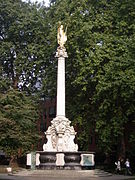St Paul's Cross

Paul's Cross (alternative spellings – "Powles Crosse") was a preaching cross and open-air pulpit in St Paul's Churchyard, the grounds of Old St Paul's Cathedral, City of London. It was the most important public pulpit in Tudor and early Stuart England, and many of the most important statements on the political and religious changes brought by the Reformation were made public from here. The pulpit stood in 'the Cross yard', the open space on the north-east side of St Paul's Churchyard, adjacent to the row of buildings that would become the home of London's publishing and book-selling trade.[1]
A monumental memorial column called "Paul's Cross" with a golden statue of St Paul stands in this area of the Cathedral precinct since the early 20th century, but it is not on the exact spot where Paul's Cross stood. A stone carved with the words 'Here stood Paul's Cross' marks the actual location of the pulpit as it stood from 1449 until 1635, when it was taken down during Inigo Jones' renovation work.
History
Pre-15th century
The eastern half of the Cross churchyard had been controlled by the Corporation in the Middle Ages: it was the site of the London '
A Richard Walker from
Jane Shore, mistress of King Edward IV was brought before the cross in 1483 and divested "of all her splendour".
On Sunday 22 June 1483, a Cambridge Doctor of Theology, Ralph Shaa, was commissioned to preach a sermon from St Paul's Cross, in which he set forth Richard, Duke of Gloucester's claim to be King of England. This was a key stage in the process of Richard III usurping the throne of his nephew Edward V, one of the Princes in the Tower.[3]
15th century
Bishop Thomas Kempe rebuilt the cross in 1449 in grand architectural form, as an open-air pulpit of mostly timber with room for three or four inside it, set on stone steps with a lead-covered roof and an ambulatory around it.[4] This ambulatory would be closed in with a low wall in the early seventeenth-century. In all, the pulpit building formed an octagon about thirty-seven feet in diameter.[5]

16th century

For much of the sixteenth and early seventeenth centuries, sermons were preached here on a weekly basis all year round. The preachers were appointed by the bishops of London. For important events or at politically sensitive times, senior clerics (including deans and bishops) would be called on to preach; on less important Sundays, the bishop and his chaplains looked to newly ordained preachers from Oxford and Cambridge, or to local London preachers, to fill the rota. Early in the reign of Queen Elizabeth I, it was sometimes difficult to find preachers willing to undertake a two-hour sermon at Paul's Cross.
Audience
References to Paul's Cross sermons in contemporary diaries and other texts suggest that the sermons were popular in the reigns of Elizabeth I and James VI and I but that they declined in popularity in the 1630s, particularly after 1635 when they moved into the relatively confined space of the Cathedral choir. One Elizabethan guide to learning French, Claudius Hollybrand's The French Schoolmaster (1573) describes a visit to the Paul's Cross sermons and reports that members of the court and senior clerics might be seen there. Attendance by the Lord Mayor and aldermen of London and their wives was far more common than the nobility, however. The guildsmen also attended Paul's Cross sermons, often sitting together formally in their guilds for special occasions like the Accession Day sermon. Attendance at the Paul's Cross sermons became an important means for the corporation to make their civic rituals compatible with Protestant teachings in the years after the Reformation.[13]
The end of Paul's Cross
William Dugdale claimed that the pulpit cross was destroyed under the Ordinance for 'Removing monuments of Idolatry' in 1643 at the start of the First English Civil War.[14] Archival evidence demonstrates that the pulpit cross had already been destroyed by 1641, however, and it is most likely that the pulpit was taken down in 1635, when this area of the Cathedral close was used as a masons' yard during renovation work on the cathedral.[15]
20th century
Between 1908 and 1910 a new structure was erected near the site of Paul's Cross, from funds provided by the will of the barrister
References
- ISBN 9780948170065.
- ^ Blayney, Peter. "The Bookshop that Never Was, in Lena Cowen Orlin (ed.), Material London ca. 1600 (Philadelphia, 2000), p. 325".
- ISBN 978-0413295309.
- ISBN 9780521453950.
- .
- ^ John Foxe (1887 republication), Book of Martyrs, Frederick Warne and Co, London and New York, pp. 160–61
- ISBN 9780199571765.
- ^ Earle, John (1628). Micocosmographie. London.
- ISBN 9780198723615.
- ISBN 0-8032-0923-1.
- ISBN 9780199571765.
- ISBN 0719054494.
- ISBN 9783030772666.
- ^ History of St Paul's Cathedral (1658), p. 134
- ^ Morrissey, Politics and the Paul's Cross Sermons, 1558-164 2, p. 34.
- ^ Ward-Jackson, Philip (2003). Public Sculpture of the City of London. Public Sculpture of Britain. Liverpool: Liverpool University Press. pp. 384–6.
- ^ Historic England. "St Paul's Cross (1194637)". National Heritage List for England. Retrieved 25 October 2014.
External links
- St Paul's Cross – Britannia.com
- E. Beresford Chancellor's St. Paul's Cathedral (1925)
- Benjamin Vincent's A Dictionary of Dates, London 1863



